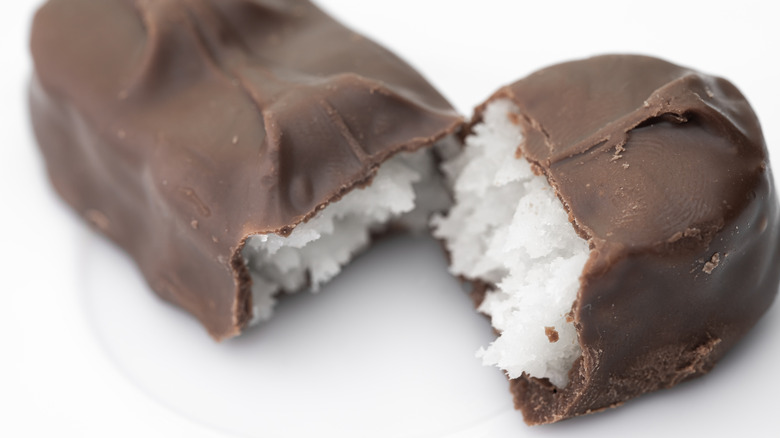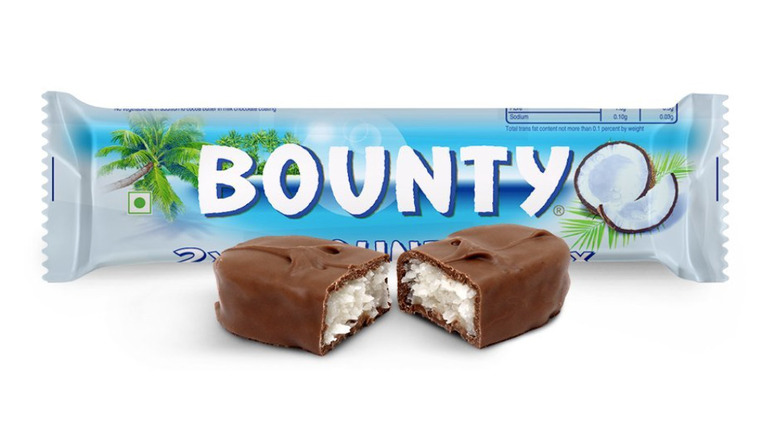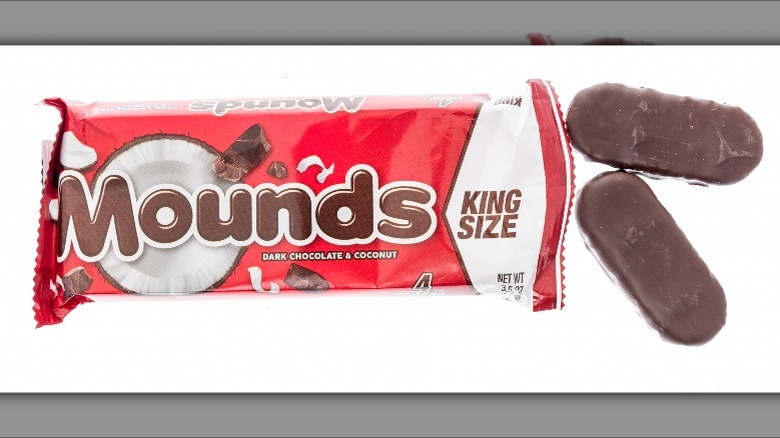What Flavor Is A Bounty Candy Bar And How Does It Compare To Mounds?
A memorable jingle may help candy lovers differentiate between Almond Joy and Mounds candy bars, but what about Bounty? We're here to help clear the area between these two coconut-flavored candy bars that appear to be shaped similarly but offer different eating experiences for those craving something sweet at home or inside the movie hall.
From the types of chocolate used to coat each candy bar to the flavors and textures found inside of the chocolate-coated fillings, Bounty and Mounds candy bars deliver distinct treats for discerning candy lovers. Which candy bar you prefer to enjoy is best left up to you, but armed with the knowledge of the subtle variations between these two treats, you'll be better equipped the next time you find yourself browsing boxes of sweets stacked in the candy aisle. Plus, depending on where you live, you may have an easier time finding one of the two brands for purchase.
Bounds candy bars have bold taste and texture
Bounty candy bars arrived on the candy scene in 1951 and were launched by Mars Incorporated. The ample, chewy coconut filling of Bounty candy bars can be found in either a creamy milk chocolate layer or a smooth dark chocolate shell. Because Bounty is sold in both milk chocolate and dark chocolate flavors, candy lovers can take their pick depending on their preferences and baking needs. To the informed eye, a specific pattern on top of a Bounty candy bar can be seen: Three waves of chocolate line the top of each candy bar.
For a limited time, a slew of other Bounty flavors were unveiled in specific countries. Australia saw cherry-flavored Bounty bars for nearly a decade, and mango Bounty bars were sold in Europe, Russia, and Ukraine for a limited time. A pineapple flavor briefly appeared in Russian markets in 2014, but consumers in Europe and Canada are mostly familiar with the traditional flavor.
Mounds is the original coconut chocolate candy
Mounds bars are coated in dark chocolate, and unlike the intentionally-poured drips of chocolate found on the surface of a Bounty bar, Mounds' chocolate shells are comparatively flat. A Mounds bar, however, has an edge when it comes to history: Mounds was the first coconut-filled chocolate bar to be sold. In 1920, Vincent Nitido came up with the idea to pair coconut and chocolate in candy bar form, and the Hershey Company eventually bought the product.
Keen American and European snack lovers may find that Mounds offer a bit more chocolate than Bounty bars. If you're feeling ambitious, you can make your own version of the treat, tailor the filling to meet your coconut desires and choose the perfect chocolate coating to address your sweet fix. Simply gather shredded coconut, powdered sugar, coconut condensed milk, and the chocolate chips of your choosing, and you have all the ingredients you need to mix up a sweet coconut filling and dip shapes into chocolate to coat and let set.
Whether you're a Mounds or Bounty fan, you can always find creative ways to sneak the candy into recipes for cakes, muffins, pancakes, ice cream, and milkshakes. A true candy lover has no limit when it comes to welcoming candy into the kitchen.


